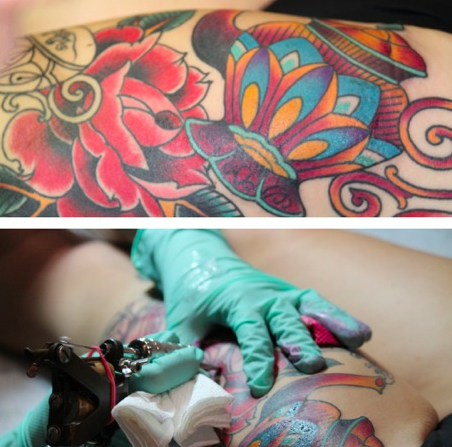A Guide to Tattoo Removal
With the increased popularity of tattoos in recent times comes an increase in an emerging trend to have tattoos removed.
The motivation for people in acquiring a tattoo vary greatly from being cultural, medical, fashionable, lifestyle, wanting to express themselves in an unique way or an act of rebellion. When tattoos are no longer relevant to their lifestyle effective removal methods are being sought.
At a 2013 American Academy of Dermatology meeting, a paper presented surveyed 500 tattooed adults with nearly 1/3 regretting getting a tattoo.
How is a Tattoo Achieved?
A tattoo involves multiple punctures of the skin to instill pigment into the dermal layer, pain as well as some minor bleeding is involved. Because of this, the use of topical anesthetics cream may be used to diminish the discomfort.
Types of Ink used in Tattooing – the vast majorities of inks are derived from metals, contain different compositions and pigment size. Eg; Black ink is relatively easy to remove because the pigment molecule is ½ the size of other colours, does not contain metals and absorbs light at every wavelength.
Red is also fairly easy to remove, but other colors, such as green, brown, yellow, and orange prove more challenging.
-
Red –Mercury
-
Black- Carbon
-
Yellow – cadmium
-
Blue – Cobalt salts
-
Green –Chromium
-
Purple/Violet –Manganese
-
Brown-Ferric oxide or Cadmium
-
White-Titanium Dioxide
Types of Tattoos
-
Professional tattoos- are performed by professionals who place the ink deep place and of the right composition to make it last for years or decades. Inks used by Professional Tattoo artists contain metal oxides which can make removal more difficult and needing more treatments .
-
Amateur tattoos are one of the most common type of tattoos, performed by individuals who are not well versed in the process and can be made in many ways. A tattoo gun may be made using a guitar string and a battery or they may simply use a needle by hand.. It is unusual to see colors other than black in amateur tattoos and are generally easier to remove.
-
Medical tattoos These are rare tattoos, placed by medical professionals for the purpose of marking body parts such as nipple re-construction in a patient with post-mastectomy breast and nipple re-construction. Also, medical tattoos are used as markers for administering radiation therapy.
-
Cosmetic tattoos These can be performed by both a professional tattoo artist and a dermatologist. Although cosmetic tattoos are composed of a mixture of compounds, the pink, red, and flesh-colored tones often contain ferric oxide and titanium dioxide [5].
-
Traumatic tattoos Traumatic tattoos are undesirable tattoos caused by different foreign bodies such as fireworks’ particles, sand, metals, glass, gunpowder, asphalt, dust, or petroleum products embedded in the dermis .Traumatic tattoos require special consideration as the responsible pigment may react dangerously with laser therapy.
Methods of Removal
The various methods of tattoo removal that have been used are excision, cryotherapy, dermabrasion, salabrasion, (using salt to abrade) cauterisa- tion, infrared coagulation, and ablation with CO2 Laser. These modalities most often result in incomplete removal of the tattoos or varying degrees of scarring and dyspigmentation.
Currently the standard of care in the removal of tattoos is the Q-switched laser but it is painful, expensive and time consuming with sometimes varying results.
Quality- switched (QS) lasers use photothermolysis selectively targeting and destoying tattoo pigments creating minimal damage to the surrounding tissue. An immediate whitening reaction occurs. This whitening is temporary and is caused by rapid local heating of the pigment causing gas formation and is an indicator for proper light absorption. Later a scab is formed; keeping the wound moist and covered with petroleum based emollient until the scab falls off will assist in the healing process.
Different Wavelengths of Q-switch Lasers
Removal success depends on choosing the wavelength, that is best absorbed by specific colours. Not all Q-switched lasers treat all colours effectively.
Mechanism of Laser Tattoo Removal
Photothermolysis selectively targets the tattoo pigment with short intense pulses of laser light, which is absorbed by the pigment causing disintegration of pigments into smaller fragments, which are then phagocytosed by macrophages or carried away via the lymphatic system.
Treatments – What to Expect
A thorough consultation process includes diagnosing skin type, any underlying lesions which may be disguised by the tattoo- such as skin cancer, tattoo colours, foreseeable complications such as scarring, skin diseases or allergic reactions to the pigment, all need to be considered when choosing wavelengths and laser parameters prior to removal.
-
A test patch prior to treatment should be performed to assess for risk of adverse reactions
-
Treatments are performed at 6-8 week intervals
-
4-6 treatments needed and up to 20
-
The number of treatments needed depends upon pigment colour, composition, density ,depth, age of the tattoo and body location
-
The sensation of a rubber band flicking the skin followed by a bad case of sunburn post treatment
-
Topical anaesthetic may be used when treating larger tattoos
-
Costs vary ranging from $120-700 depending on size of the tattoo
-
Extremities such as fingers and toes take longer to fade
-
Other factors to consider when evaluating tattoos for removal are their location on the body and the age and skin type of the patient.
Post Treatment Care-reducing the side effects
Adjuvant Topical Therapies
Tri luma –a commercially available bleaching agent containing tretinoin hydroquinone and fluocinlone. It lightens the epidermal pigment overlying the tattoo and treats post inflammatory hyperpigmentation.
ImIquimod – when used together laser therapy helps increase tattoo clearance but increases risk of inflammation and fibrosis post treatment.
Contatubex – gel aiding in preventing hypertrophic and keloid scars
Factors Affecting Successful Removal
Choosing the correct wavelength-colour is necessary for a successful outcome. Not all Q-switched lasers remove all colours effectively and more than 1 laser is needed when removing multi coloured tattoos.
Complicating matters, neither the tattoo artist nor the clinician knows exactly what is in the ink, and this information would be helpful in making the decision about the most appropriate type of laser for the task.
Decreased clinical success have been observed in tattoos with colours other than black and red, tattoos larger than 30 cm2, tattoos located on the feet or legs, tattoos older than 36 months and tattoos with high colour density.
Complications
New Developments
Picosecond Lasers – are lasers with shorter pulse duration and more rapid heating decreasing the number of treatments necessary needed for effective removal.
Pulsed dye TRASER-Total Reflection Amplification Spontaneous Emission of Radiation. – a single tunable device that may be able to do away with multiple wavelenths of laser equipment.
Microencapsulated pigment – the microspheres contains a permanent but easily removable ink which can be easily targeted by specific wavelengths. To date studies have only been investigated on rats although results are promising.
Fractional resurfacing – is a type of photothermolysis which creates microzones of injury in the skin. These microzones are surrounded by normal skin enabling it to heal rapidly resulting in great cosmetic outcomes.
References:
Sonal Choudhary & Mohamed L. Elsaie & Angel Leiva & Keyvan Nouri, Lasers for tattoo removal: a review Lasers Med Sci (2010) 25:619–627 DOI 10.1007/s10103-010-0800-2
Stefanie Luebberding, PhDa,*,Macrene Alexiades-Armenakas, MD, PhDa,b,
New Tattoo Approaches in Dermatology ,Dermatol Clin 32 (2014) 91–96











